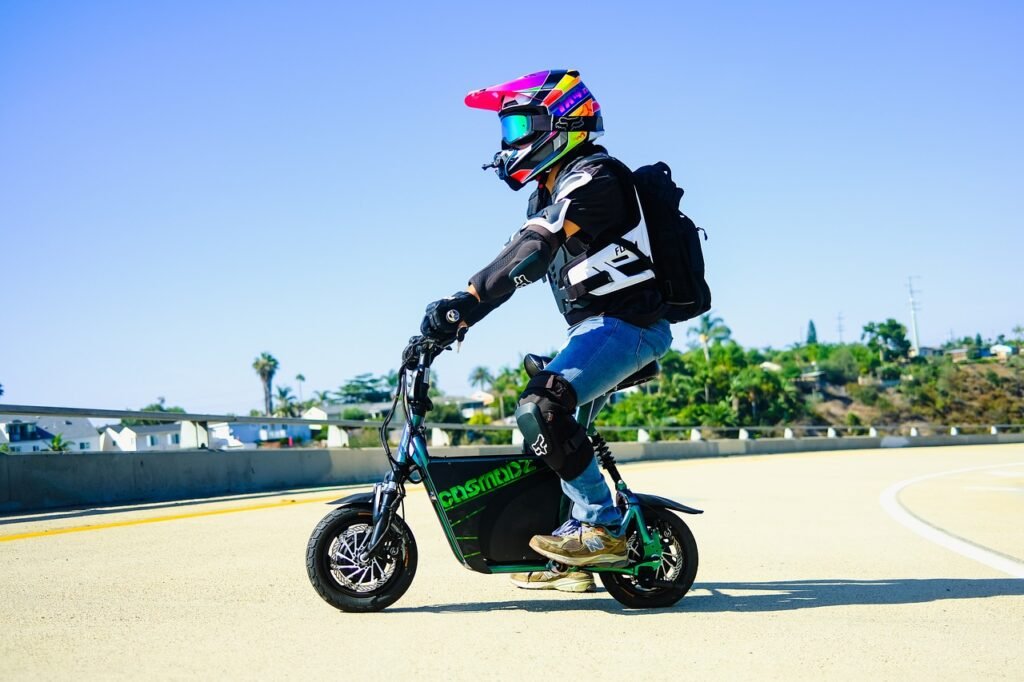
Whether you’re a seasoned scooter rider or just starting out, it’s crucial to prioritize your safety on the road. In this article, we’ll provide essential tips to help you stay safe while riding your scooter. From wearing protective gear to following traffic rules, these simple yet crucial measures will ensure a worry-free and enjoyable scooter riding experience. So, grab your helmet, fasten your seatbelt, and let’s explore the essential scooter riding safety tips that will keep you riding with confidence.

This image is property of pixabay.com.
Check out our product reviews!
Pre-Ride Preparations
Before you hop on your scooter and hit the road, it’s essential to take a few important steps to ensure a safe and enjoyable ride. Just like preparing for any other journey, a little preparation goes a long way in keeping you safe. Here are a couple of things you should consider before starting your ride.
Check the scooter condition
One of the first things you should do is perform a quick inspection of your scooter. Check the tires for any signs of wear or damage and ensure they are properly inflated. Look for any loose screws or bolts and tighten them if necessary. Make sure all the lights are working correctly, including the brake lights and turn signals. Finally, check the fuel level and top it up if needed. Taking a few minutes to ensure your scooter is in good condition can prevent any unexpected issues during your ride.
Wear appropriate safety gear
Just like when riding a bicycle or motorcycle, wearing the right safety gear is crucial when riding a scooter. Protecting your head is of utmost importance, so don’t forget to wear a helmet that fits correctly and is securely fastened. Additionally, consider wearing gloves to protect your hands, especially during colder weather. Depending on your local regulations, you may also need to wear other safety gear, such as knee and elbow pads. Remember, safety should always be your top priority, and wearing the appropriate gear can significantly reduce the risk of injury in case of an accident.
Understanding Traffic Regulations
Being knowledgeable about traffic laws and regulations is essential for every scooter rider. Whether you’re commuting to work or enjoying a leisurely ride on the weekend, familiarizing yourself with local traffic regulations is a must.
Familiarize yourself with local traffic laws
Each region or country may have its own unique set of traffic laws, so taking the time to familiarize yourself with them is crucial. Some things to pay attention to include the speed limits, right-of-way rules, and any specific regulations pertaining to scooter riders. This information can typically be found in your local Department of Transportation or on their website.
Obey traffic signs and signals
Just like any other road user, scooter riders must adhere to traffic signs and signals. Always stop at red lights and stop signs and proceed with caution when the light turns green. Pay close attention to pedestrian crosswalks, school zones, and other areas with specific regulations. By obeying traffic signs and signals, you not only keep yourself safe but also contribute to the overall flow and safety of traffic.
Understand scooter-specific regulations
In addition to general traffic laws, scooter riders may also be subject to certain regulations specific to their vehicle type. Some areas may require scooters to stay within designated bike lanes, while others may allow them on regular roads. Make sure you are aware of these regulations and follow them accordingly. Understanding the specific regulations for scooters will help ensure a safer and smoother ride.

This image is property of pixabay.com.
Check out our product reviews!
Choosing the Right Route
Planning your route ahead of time can make a significant difference in your riding experience. By taking the time to choose the right route, you can avoid high-traffic areas, select well-lit roads, and have a more enjoyable journey.
Plan your route in advance
Before you embark on your scooter ride, it’s a good idea to plan your route in advance. Identify the roads you want to take and have a general idea of the distances involved. Consider using map applications or other navigation tools to assist you in finding the best route based on your preferences. Taking the time to plan ahead will help you avoid getting lost and minimize the chances of encountering challenging road conditions.
Avoid high-traffic areas
While riding your scooter, it’s generally best to avoid areas with heavy traffic. Crowded roads can be stressful and increase the risk of accidents. Instead, opt for less congested routes, even if they are slightly longer. Not only will you have a more pleasant ride, but you’ll also reduce the chances of encountering dangerous situations amidst heavy traffic.
Select well-lit and smooth roads
When choosing your route, prioritize well-lit and smooth roads. Adequate lighting enhances visibility, making it easier for other road users to see you. Smooth roads, on the other hand, provide a more comfortable and stable ride. Avoid poorly maintained roads with potholes or rough patches that could potentially lead to accidents or damage to your scooter. Taking these factors into consideration when selecting your route will contribute to a safer and smoother journey.
Maintaining Proper Scooter Control
Having proper control over your scooter is essential for safe riding. By following these guidelines, you can maintain stability, react effectively in different situations, and minimize the risk of accidents.
Hold the handlebars firmly
Always maintain a firm grip on the handlebars of your scooter. This ensures that you have full control over the vehicle and can maneuver safely. Keep both hands on the handlebars at all times while riding, avoiding distractions or activities that may compromise your ability to maintain proper control.
Keep both feet on the scooter’s floorboard
When riding your scooter, it’s important to keep both feet planted on the scooter’s floorboard. This provides stability and balance, especially when coming to a stop or navigating turns. Avoid extending your legs or resting them on the ground while riding, as this can affect your control and compromise safety.
Apply brakes gradually and evenly
Properly using your scooter’s brakes is crucial for maintaining control and ensuring a safe ride. When coming to a stop or slowing down, apply the brakes gradually and evenly. Sudden or harsh braking can cause the scooter to skid or lose balance, leading to accidents. Getting accustomed to the sensitivity of your scooter’s brakes and using them smoothly will contribute to a safer riding experience.
Use turn signals when changing direction
Just like driving a car, signaling your intentions when changing direction is vital for the safety of both you and other road users. When making a turn or changing lanes, use your scooter’s turn signals to indicate your intentions. This helps other drivers anticipate your movements and reduces the risk of collisions. Remember to turn off your signals once the maneuver is completed to avoid confusing other road users.
Avoid sudden swerving or harsh maneuvers
Maintain a steady and predictable riding style, avoiding sudden swerves or harsh maneuvers unless absolutely necessary. Abrupt changes in direction or sudden acceleration can startle other road users and increase the risk of accidents. Instead, plan your movements in advance and execute them smoothly and confidently.

This image is property of pixabay.com.
Maintaining Visibility
Being visible to other road users is crucial for your safety while riding a scooter. By taking a few simple steps, you can enhance your visibility and reduce the risk of accidents.
Wear bright and reflective clothing
One effective way to increase your visibility on the road is by wearing bright and reflective clothing. This makes it easier for other drivers to see you, especially in low-light conditions or during inclement weather. Opt for brightly colored jackets or vests with reflective strips to enhance your visibility and make you stand out on the road.
Install front and rear lights on your scooter
Equipping your scooter with front and rear lights is essential for both your safety and the safety of others. Ensure that your scooter’s headlights, taillights, and brake lights are functioning correctly and are bright enough to be seen by other road users. Using lights during both the day and night significantly increases your visibility, reducing the risk of accidents.
Use hand signals to indicate turns
In addition to using your scooter’s turn signals, it’s a good idea to use hand signals to indicate your intentions. This provides an extra layer of communication to other drivers, especially in situations where your scooter’s signals may not be clearly visible. Simply extending your arm to the left or right to indicate your intended turn can help prevent misunderstandings and ensure safer riding.
Ensure mirrors are properly adjusted
Your scooter’s mirrors are invaluable tools for maintaining awareness of your surroundings. Before you start your ride, take a moment to properly adjust your mirrors, ensuring that you have a clear view of the traffic behind you. Regularly glance at your mirrors while riding to stay informed about the positions of other vehicles and anticipate their actions.
Being Aware of Surroundings
Maintaining awareness of your surroundings is essential for staying safe on the road. By remaining vigilant and proactive, you can identify potential hazards and react accordingly.
Scan the road ahead for potential hazards
While riding, continuously scan the road ahead to identify any potential hazards. Keep an eye out for obstacles, potholes, or debris that may pose a danger to you or your scooter. By anticipating these hazards, you can adjust your riding accordingly and avoid accidents.
Check blind spots before changing lanes
Before changing lanes or making any lateral movements, be sure to check your blind spots. These are areas where your mirrors may not provide full visibility. Turn your head and physically check over your shoulder to ensure there are no vehicles in your blind spots before changing lanes. This simple habit helps prevent collisions and ensures safer lane changes.
Anticipate the actions of other drivers
Being able to predict the actions of other drivers is a crucial skill for safe riding. Pay attention to the behavior and patterns of the vehicles around you, as this can give you insights into their next moves. By anticipating other drivers’ actions, you can adjust your position and riding style accordingly, reducing the risk of accidents and improving overall safety.
Defensive Riding Techniques
Adopting defensive riding techniques adds an additional layer of safety to your scooter journeys. By maintaining a proactive mindset and taking precautions, you can significantly reduce the chances of accidents or collisions.
Keep a safe following distance
Maintaining a safe distance between your scooter and the vehicle in front of you is essential for defensive riding. This provides you with sufficient reaction time in case the vehicle in front suddenly stops or slows down. Aim to keep a distance of at least two seconds from the vehicle ahead to ensure a safe and efficient ride.
Watch for opening car doors
While riding near parked cars, always be mindful of the potential for car doors to open suddenly. Keep a close eye on parked vehicles and be prepared to swerve or adjust your path if necessary. By staying alert and vigilant, you can avoid colliding with opening car doors and prevent accidents.
Stay in your lane
Unless it is necessary to change lanes, always stay within your designated lane. Avoid weaving in and out of traffic or overtaking vehicles without sufficient space. By staying in your lane and maintaining a consistent position, you reduce the risk of collisions and improve your overall safety.
Stay visible to other motorists
Visibility is a key element of defensive riding. Ensure that you are visible to other motorists by using your lights, wearing reflective clothing, and positioning yourself appropriately on the road. By making yourself more conspicuous, you increase your chances of being seen and reduce the chances of accidents caused by lack of visibility.
Avoiding Distractions
Remaining focused and avoiding distractions while riding your scooter is paramount to your safety. By keeping your attention solely on the road, you minimize the risk of accidents.
Do not use electronic devices while riding
Using electronic devices, such as smartphones or tablets, while riding your scooter is highly dangerous and should be avoided at all costs. Engaging with these devices takes your attention away from the road and increases the chances of accidents. To ensure your safety and the safety of others, keep your electronic devices safely stowed away while riding.
Stay focused on the road
Maintain a focused mindset while riding your scooter. Keep your attention on the road ahead, scanning for potential hazards and maintaining awareness of your surroundings. Avoid daydreaming or zoning out, as this can compromise your ability to react in a timely manner to unexpected situations.
Avoid listening to loud music
While cruising on your scooter, it may be tempting to listen to your favorite tunes. However, it’s important to avoid listening to loud music or wearing headphones while riding. Loud music can distract you from the sounds of approaching vehicles or other important auditory cues. By keeping your ears clear and focused on the traffic around you, you can react swiftly to any potential dangers.
Dealing with Adverse Weather Conditions
Adverse weather conditions can significantly impact your riding experience and safety. By taking appropriate precautions, you can navigate through rain, snow, fog, or other challenging weather conditions more safely.
Reduce speed in rain, snow, or fog
When faced with rain, snow, or fog, it’s crucial to reduce your speed to match the condition of the road. Slippery surfaces and reduced visibility require extra caution and slower speeds to maintain control over your scooter. Adjust your riding accordingly, giving yourself ample time and space to brake and react to any potential hazards.
Have proper rain gear and adequate visibility
If you plan to ride in wet weather, it’s essential to invest in proper rain gear. A waterproof jacket and pants, along with waterproof gloves and boots, will help keep you dry and comfortable. Additionally, ensure that your scooter’s lights are functioning correctly and are visible to other road users, even in heavy rain or fog.
Be cautious on slippery surfaces
Slippery surfaces, such as wet roads or icy patches, pose a significant risk to scooter riders. When encountering these conditions, exercise extreme caution, reduce your speed, and avoid sudden braking or acceleration. Be mindful of your scooter’s stability and give yourself more time to react to any potential hazards or changes in road conditions.
Parking and Securing Your Scooter
After enjoying your scooter ride, it’s important to park and secure your vehicle properly. Taking the necessary precautions will help prevent theft and ensure that your scooter remains in good condition.
Park in designated areas
When you arrive at your destination, look for designated parking areas specifically marked for scooters or motorcycles. Avoid parking in areas that restrict or obstruct the movement of pedestrians or other vehicles. By parking in designated areas, you not only comply with local regulations but also contribute to the overall organization and safety of the parking environment.
Secure your scooter with locks or alarms
Scooter theft is unfortunately a risk that riders need to consider. To protect your scooter from potential theft, use high-quality locks or alarms. Invest in a sturdy lock to secure the body of your scooter to a stationary object, such as a bike rack or a designated anchor point. Additionally, consider installing an alarm system that will deter potential thieves and draw attention to any unauthorized attempts to move or tamper with your scooter.
By following these essential safety tips and practicing responsible riding habits, you can enjoy your scooter rides while minimizing the risk of accidents or incidents. Stay safe, stay visible, and always prioritize your well-being and that of others on the road. Ride with caution, confidence, and respect for the rules of the road, ensuring that every journey is a safe and enjoyable one.




